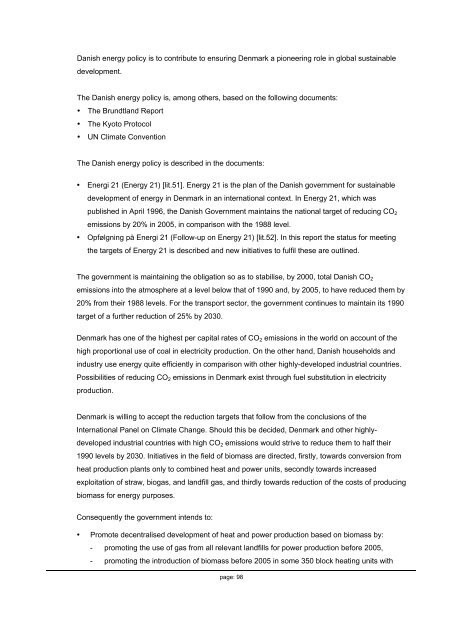Adding gas from biomass to the gas grid - SGC
Adding gas from biomass to the gas grid - SGC
Adding gas from biomass to the gas grid - SGC
- No tags were found...
You also want an ePaper? Increase the reach of your titles
YUMPU automatically turns print PDFs into web optimized ePapers that Google loves.
Danish energy policy is <strong>to</strong> contribute <strong>to</strong> ensuring Denmark a pioneering role in global sustainabledevelopment.The Danish energy policy is, among o<strong>the</strong>rs, based on <strong>the</strong> following documents:• The Brundtland Report• The Kyo<strong>to</strong> Pro<strong>to</strong>col• UN Climate ConventionThe Danish energy policy is described in <strong>the</strong> documents:• Energi 21 (Energy 21) [lit.51]. Energy 21 is <strong>the</strong> plan of <strong>the</strong> Danish government for sustainabledevelopment of energy in Denmark in an international context. In Energy 21, which waspublished in April 1996, <strong>the</strong> Danish Government maintains <strong>the</strong> national target of reducing CO 2emissions by 20% in 2005, in comparison with <strong>the</strong> 1988 level.• Opfølgning på Energi 21 (Follow-up on Energy 21) [lit.52]. In this report <strong>the</strong> status for meeting<strong>the</strong> targets of Energy 21 is described and new initiatives <strong>to</strong> fulfil <strong>the</strong>se are outlined.The government is maintaining <strong>the</strong> obligation so as <strong>to</strong> stabilise, by 2000, <strong>to</strong>tal Danish CO 2emissions in<strong>to</strong> <strong>the</strong> atmosphere at a level below that of 1990 and, by 2005, <strong>to</strong> have reduced <strong>the</strong>m by20% <strong>from</strong> <strong>the</strong>ir 1988 levels. For <strong>the</strong> transport sec<strong>to</strong>r, <strong>the</strong> government continues <strong>to</strong> maintain its 1990target of a fur<strong>the</strong>r reduction of 25% by 2030.Denmark has one of <strong>the</strong> highest per capital rates of CO 2 emissions in <strong>the</strong> world on account of <strong>the</strong>high proportional use of coal in electricity production. On <strong>the</strong> o<strong>the</strong>r hand, Danish households andindustry use energy quite efficiently in comparison with o<strong>the</strong>r highly-developed industrial countries.Possibilities of reducing CO 2 emissions in Denmark exist through fuel substitution in electricityproduction.Denmark is willing <strong>to</strong> accept <strong>the</strong> reduction targets that follow <strong>from</strong> <strong>the</strong> conclusions of <strong>the</strong>International Panel on Climate Change. Should this be decided, Denmark and o<strong>the</strong>r highlydevelopedindustrial countries with high CO 2 emissions would strive <strong>to</strong> reduce <strong>the</strong>m <strong>to</strong> half <strong>the</strong>ir1990 levels by 2030. Initiatives in <strong>the</strong> field of <strong>biomass</strong> are directed, firstly, <strong>to</strong>wards conversion <strong>from</strong>heat production plants only <strong>to</strong> combined heat and power units, secondly <strong>to</strong>wards increasedexploitation of straw, bio<strong>gas</strong>, and landfill <strong>gas</strong>, and thirdly <strong>to</strong>wards reduction of <strong>the</strong> costs of producing<strong>biomass</strong> for energy purposes.Consequently <strong>the</strong> government intends <strong>to</strong>:• Promote decentralised development of heat and power production based on <strong>biomass</strong> by:- promoting <strong>the</strong> use of <strong>gas</strong> <strong>from</strong> all relevant landfills for power production before 2005,- promoting <strong>the</strong> introduction of <strong>biomass</strong> before 2005 in some 350 block heating units withpage: 98
















